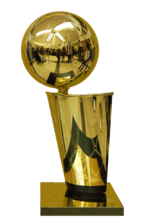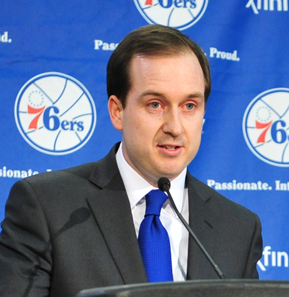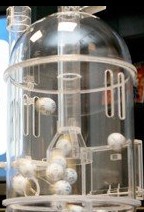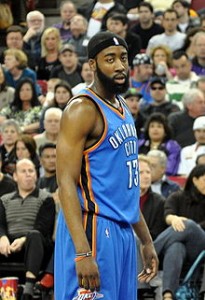 PHILADELPHIA – Let’s begin with a question.
PHILADELPHIA – Let’s begin with a question.
In the three-plus decades since David Stern took the reins as NBA commissioner from Larry O’Brien and handed them to Adam Silver, what do these franchises – the Atlanta Hawks, Minnesota Timberwolves, Golden State Warriors, Memphis Grizzlies, Toronto Raptors, Sacramento Kings, Washington Wizards, New Orleans Pelicans, Charlotte Hornets, Milwaukee Bucks and Los Angeles Clippers – have in common?
Answer: None has gone to the NBA Finals. Furthermore, among that group only Denver, Minnesota, Milwaukee, Sacramento and Memphis have even made it to the conference finals.
Think about that; more than three decades of futility for more than a third of the League. If you were growing up in Washington in 1984 when Stern came walking through that door and Orwell’s “Big Brother’’ started watching you, not only have you not seen the Bullets – now the Wizards – but neither have your children and possibly even your grandchildren.
Is it any wonder, then, that when franchises do those kind of analytics they quickly come to the realization that the only chance to escape perpetual mediocrity is to first sink to the depths, then hope to climb back up – with no assurance it will work?
So why penalize a team that’s simply trying to beat a system that been stacked against it for years? In particular, why is Silver leading the charge to stick it to the Philadelphia 76ers, who have had the temerity to announce to the hoops world that you have to bad – really bad – to be good?
“So that’s our plan. And we’re sticking to it.’’
Even if the product the Sixers put out on the floor embarrasses not only themselves but the rest of the NBA. Last season, despite winning their first three games – including an exhilarating come-from-behind opener vs. LeBron James and the defending champion Miami Heat – the Sixers quickly plummeted toward the bottom.
They did so with a roster that stopped being competitive in January that was centered around versatile forward Thaddeus Young, 2010 No. 2 pick Evan Turner and precocious point guard Michael Carter-Williams, the eventual Rookie of the Year.
Top draft pick Nerlens Noel was nowhere to be seen. After tearing his ACL during his freshman season at Kentucky, he still entered the draft. But the 6-11 shot-blocking specialist spent the entire season healing, all a designed part of Sixers GM Sam Hinkie’s master plan.
Despite Noel now saying he was healthy enough to play right after the All-Star break, there was never a chance. Not only didn’t Hinkie & Co. want to risk injury, they also didn’t want to do anything to jeopardize their place in the lottery, like winning too many games.
Tying the all-time major pro sports record with 26 consecutive losses wasn’t supposed to be on the menu.  But once Hinkie jettisoned Turner and big man Spencer Hawes at the trading deadline for essentially useless parts and lower-tier draft choices, that became almost inevitable.
But once Hinkie jettisoned Turner and big man Spencer Hawes at the trading deadline for essentially useless parts and lower-tier draft choices, that became almost inevitable.
When the season mercifully came to an end – a season which included 23 different players, some acquired not only from the D-League but also overseas – Sixers owner Josh Harris infuriated the local populace – not to mention Silver and the rest of the league – by calling it “a huge success.”
As it turned out, Philadelphia’s 19-63 mark – second worst in the league to Milwaukee’s 15-67 – earned it only the third pick in the draft. That wound up becoming Kansas’ 6-11 freshman Joel Embiid, who seemed ticketed to go No. 1 until suffering a stress fracture to the navicular bone in his right foot, requiring surgery.
That may have scared off Cleveland and Milwaukee, who picked 1-2. It didn’t faze Hinkie in the least. Not only did he snatch Embiid – quickly revealing he expected the big man from Cameroon to be sidelined five to eight months and quite possibly missing the entire season – he tabbed Croatian forward Dario Saric with the 12th pick after trading down two spots with Orlando. The only problem there was the 6-10 Saric had just signed a contract to play in Turkey for at least two years before even considering the NBA.
In other words, while Noel is coming back this season – shaking off the rust with a solid showing in the Orlando and Las Vegas Summer Leagues – he is the only reinforcement to coach Brett Brown’s sorry lineup. By default, Noel most likely will be joined by three of Philadelphia’s four second-round picks: K.J. McDaniels, Jerami Grant and Jordan McRae.
Throw those pups into the pack with holdovers Carter-Williams, Young (unless he’s traded as a potential opt-out free agent next year), Tony Wroten, Hollis Thompson, Henry Sims (who did display some skills after coming over in the Hawes deal), Arnett Moultrie, summer league sensation Casper Ware and veteran Jason Richardson, who’s missed most of the last two seasons due to injuries, and it doesn’t figure to be very pretty.
But that seems just fine with all concerned here, the clear inference being that after another dreary season almost certainly resulting in another high lottery pick, the Sixers would finally have all the pieces in place to begin implementing their plan.
“Not so fast,’” has been the NBA’s response. “We don’t like what you’re doing and it has to stop.”
That’s the basis for a proposed drastic revision of the lottery formula, even though the current one has worked for 20 years without incident. By lowering the potential reward for stinking up the joint – balancing out the percentages of the weakest teams drawing the top three picks from 25 percent 19.9 percent and 15.6 percent, respectively, to 11 percent across the board for the bottom four teams – the league is hoping that the incentive to lose won’t be as high.
Noble as it sounds, there’s just one flaw. It’s not the lottery system that needs tinkering. It’s the composition of the league itself.
Since the first lottery in 1985, when Stern plucked the alleged “frozen” envelope containing the logo of the New York Knicks, who drafted Patrick Ewing, the process has been under scrutiny. The NBA has tweaked the system a handful of times, the intent always being to theoretically strengthen the poor – in this case the teams with the worst records – and weaken the rest.
Now, following a season where not only the Sixers, but the Bucks, Magic, Jazz and even the stories Celtics made it abundantly clear that losing was the best road to future prosperity, there is sentiment is to change it again and balance the odds.
Considering the fact that only three times in the lottery’s 31-year history has the team with the worst record has received the top pick (Danny Manning to the Clippers in 1988, Derrick Coleman to the Nets in 1990 and Dwight Howard to the Magic in 2004), you can’t help but wonder why any change is necessary.
There are also these non-Denver nuggets to consider: In the lottery era, only two top overall picks in the draft – David Robinson in 1987 and Tim Duncan a decade later – have gone on to win a championship with their original team. They, of course, did it together with San Antonio.
The other top overall picks who went on to win a ring – Shaquille O’Neal (1992), Glenn “Big Dog’’ Robinson (1994) and LeBron James (2003) – had to move on and do it elsewhere. Among the rest, only Ewing (1985), Allen Iverson (1996), Kenyon Martin (2000) and Howard (2009) ever got to the Finals.
Clearly, there’s something inherently wrong with a league where only eight franchises have hoisted the championships trophy in those 31 years. Unless you have rooted for the Lakers (8 titles), Bulls (6), Spurs (5) Pistons (3), Heat (3) Celtics (3), Rockets (2) or Mavericks (a measly one), you’ve never had a celebration.
In contrast baseball has had 18 different champions in that span, while the NFL and NHL have had 16 and 15, respectively.
Obviously, the NBA, with much smaller rosters where one or two studs can boost a team to contention and keep it there for years and years, has done a lousy job distributing the power. If you can’t sign those superstars the way the Heat in 2010 and the Cavaliers are in the process of doing now that James has come  back home, the smart thing is to develop your own.
back home, the smart thing is to develop your own.
By virtue of three straight miserable seasons, the Oklahoma City Thunder were able to draft Kevin Durant, Russell Westbrook and James Harden while also finding Serge Ibaka 20 picks after they took Westbrook. Give them credit for that, but keep in mind they are by far the exception rather than the rule.
The point is there is no perfect antidote for what ails the NBA. But that doesn’t mean it’s time to change the rules in the middle of the game. The Sixers and Celtics especially have figured out the system is rigged against the vast majority. When you’re up, you stay up. When you’re down, you at least have a chance to climb back. When you’re in the middle of the pack, forget it.
Perhaps changing the lottery will have its desired effect and allow Silver and his cohorts to sleep better at night believing the integrity of the game has been preserved. But that won’t change a bigger problem: the fact that not all NBA teams have been created equal.
Unless that somehow that gets rectified and gives every team a fair shot at the holy grail, the questions about what’s wrong with the NBA will remain unanswered.
Jon Marks has covered the Philadelphia 76ers from the days of Dr. J and his teammate, Joe Bryant (best known as Kobe’s dad). He has won awards from the Pro Basketball Writers Association and North Jersey Press Club. His other claim to fame is driving Rick Mahorn to a playoff game after missing the team bus. Follow him on Twitter.
It is inaccurate to state that the Kings, Bucks, Wizards and Warriors have never been to an NBA finals. The Kings were formerly the Rochester Royals. They were one of the original teams that formed the NBA. They won an NBA championship against the Knicks in the early 1950’s. The Bucks went to the finals when Kareem Abdul-Jabbar was with them. The Warriors also went to the finals when they were in Philly and California. Needless to say the Wizards were formerly known as the Baltimore Bullets and later as the Washington Bullets. They went to the finals under both names.
He’s saying in the last 30 years they have not reached the finals
I think part of the issue is also the current “one and done” situation in particular in the 2000s. In the 80s and 90 a lottery pick meant “generally” (yes I know there Pervis, Billy Owens, Armon Gilliams,, etc that were average to bust) meant you were getting a building block or a strong contributor.
Nowadays it’s a crap shoot, high school players removed and still a top 10 player you’re still not sure about.
What’s even more mind boggling is you ask, “are the Spurs that smart”? They’ve consistently drafted low because of their success and their draft picks tend to work out. Or is it they know how to pick the right players that fit in their system?
When you add that their structure has been in place for years, maybe that’s the secret sauce other teams should copy.
He is talking about in the last 31 years they have not been to the finals
Sorry replied on the wrong post
Terrible idea to allow teams that aren’t terrible to get a top pick.
NBA shouldn’t overreact to a couple of bad apples in a year with great draft picks.
A team like Phila and MIL is suffering enough by being bad, not to have to suffer even more.
To have only a 25% chance to get the #1 pick by being worst team, is already enough punishment.
I recall when New Jersey clearly had the worst team in NBA, and they weren’t trying to tank – just the opposite. They deserved to get the number 1 pick and draft Wall. Instead they were punished and only got the #3 pick (Favors) that eventually became Deron Williams with addition of 2 1st round picks.
Also, teams don’t directly TANK. The FO trades away their players in an attempt to rebuild. They also play some of their young players to give them experience. The players on the court actually try to win. However, for the case of the 2010 Nets as well as many other cases, you can’t even blame the front office or coaching staff.